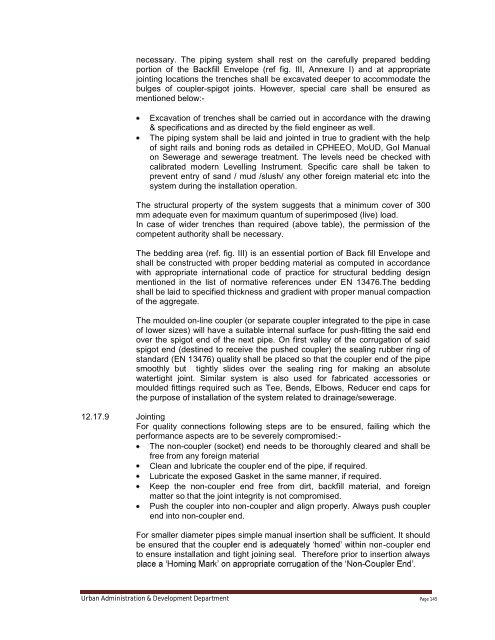Specifications Part 1 - Water Supply, Sewerage and Tube Well Works
Specifications Part 1 - Water Supply, Sewerage and Tube Well Works
Specifications Part 1 - Water Supply, Sewerage and Tube Well Works
Create successful ePaper yourself
Turn your PDF publications into a flip-book with our unique Google optimized e-Paper software.
necessary. The piping system shall rest on the carefully prepared beddingportion of the Backfill Envelope (ref fig. III, Annexure I) <strong>and</strong> at appropriatejointing locations the trenches shall be excavated deeper to accommodate thebulges of coupler-spigot joints. However, special care shall be ensured asmentioned below:-Excavation of trenches shall be carried out in accordance with the drawing& specifications <strong>and</strong> as directed by the field engineer as well.The piping system shall be laid <strong>and</strong> jointed in true to gradient with the helpof sight rails <strong>and</strong> boning rods as detailed in CPHEEO, MoUD, GoI Manualon <strong>Sewerage</strong> <strong>and</strong> sewerage treatment. The levels need be checked withcalibrated modern Levelling Instrument. Specific care shall be taken toprevent entry of s<strong>and</strong> / mud /slush/ any other foreign material etc into thesystem during the installation operation.The structural property of the system suggests that a minimum cover of 300mm adequate even for maximum quantum of superimposed (live) load.In case of wider trenches than required (above table), the permission of thecompetent authority shall be necessary.The bedding area (ref. fig. III) is an essential portion of Back fill Envelope <strong>and</strong>shall be constructed with proper bedding material as computed in accordancewith appropriate international code of practice for structural bedding designmentioned in the list of normative references under EN 13476.The beddingshall be laid to specified thickness <strong>and</strong> gradient with proper manual compactionof the aggregate.The moulded on-line coupler (or separate coupler integrated to the pipe in caseof lower sizes) will have a suitable internal surface for push-fitting the said endover the spigot end of the next pipe. On first valley of the corrugation of saidspigot end (destined to receive the pushed coupler) the sealing rubber ring ofst<strong>and</strong>ard (EN 13476) quality shall be placed so that the coupler end of the pipesmoothly but tightly slides over the sealing ring for making an absolutewatertight joint. Similar system is also used for fabricated accessories ormoulded fittings required such as Tee, Bends, Elbows, Reducer end caps forthe purpose of installation of the system related to drainage/sewerage.12.17.9 JointingFor quality connections following steps are to be ensured, failing which theperformance aspects are to be severely compromised:-The non-coupler (socket) end needs to be thoroughly cleared <strong>and</strong> shall befree from any foreign materialClean <strong>and</strong> lubricate the coupler end of the pipe, if required.Lubricate the exposed Gasket in the same manner, if required.Keep the non-coupler end free from dirt, backfill material, <strong>and</strong> foreignmatter so that the joint integrity is not compromised.Push the coupler into non-coupler <strong>and</strong> align properly. Always push couplerend into non-coupler end.For smaller diameter pipes simple manual insertion shall be sufficient. It shouldbe ensured that the coup-coupler endto ensure installation <strong>and</strong> tight joining seal. Therefore prior to insertion always-Urban Administration & Development Department Page 145
















